





|
Research |
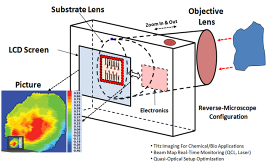
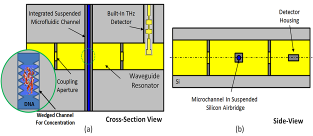

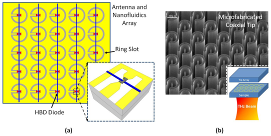
|
1. High Performance Terahertz Detection |
|
2. Advanced THz Imaging |
|
3. Tunable and Reconfigurable THz Circuits and Components |
|
In the last several years, we have focused research on advanced THz sensing and imaging using novel high-speed devices and materials to deliver superior performance and unique functionalities. In particular, our current research is directed at five main areas: |
|
Current Sponsors: |



|
Collaborators: Hsueh-Chia Chang, University of Notre Dame (Dept. of Chemical Engineering) Li-Jing Cheng, Oregon State University (Dept. of Electrical and Computer Engineering) Patrick Fay, University of Notre Dame (Dept. of Electrical Engineering) Jeffrey L. Hesler, University of Virginia (Dept. of Electrical and Computer Engineering) Debdeep Jena, University of Notre Dame (Dept. of Electrical Engineering) A. W. Lichtenberger, University of Virginia (Dept. of Electrical and Computer Engr.) C. M. Megaridis, University of Chicago, Illinois (Dept. of Mech. & Indus. Engr.) Alexei Orlov, University of Notre Dame (Dept. of Electrical Engineering) Gregory Snider, University of Notre Dame (Dept. of Electrical Engineering) Robert M. Weikle, II, University of Virginia (Dept. of Electrical and Computer Engr.) Tao Wang, University of Notre Dame (Dept. of Electrical Engineering) Huili (Grace) Xing, University of Notre Dame (Dept. of Electrical Engineering)
|
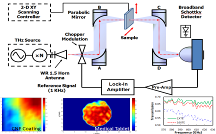
|
Our work and interests in this direction have involved developing more sophisticated integrated solid-state THz detectors with the goal of realizing circuits that permit higher-levels of performance. There are two types of detection schemes that are widely used in the THz regime, direct or incoherent detection and heterodyne or coherent detection.
In terms of THz direct detection, different types of devices including superconducting hot-electron bolometers (HEBs), pyroelectric devices, Schottky diodes and CMOS-based devices have been studied and employed for developing direct detectors operating in the THz region. However, THz detectors demonstrated to date either require cryogenic operation, or generally have exhibited relatively low responsivity and high noise equivalent power (NEP) level. In this research, high performance Antimonide-based heterostructure backward tunneling diodes (Sb-HBDs) have been successfully integrated into planar lens-coupled folded-dipole antennas (FDAs) for impedance conjugate matching without any additional matching networks for room-temperature ultrasensitive THz detectors.
As compared to direct detection, THz heterodyne detection (also called mixing) typically exhibits higher sensitivity and greater dynamic range. My group has also been actively pursuing advanced THz mixing technology (e.g. balanced mixing, image rejection mixing) through both independent research and collaborations. At present, THz receivers based on superconducting HEBs offer the advantages of high sensitivity, low noise and low local oscillator (LO) power requirement. However, single-element HEB mixers may suffer from noise introduced by LO injection and vibration. Consequently, balanced mixer designs are of great interest since the thermal noise and amplitude modulation noise from the LO can be suppressed. In this research, two high performance HEB devices have been successfully integrated into planar dual-polarization sinuous antennas (with an airbridge) for quasi-optical balanced mixer configurations to gain the advantages of both ultra-high sensitivity and extremely broad bandwidth. The advanced mixer architecture developed in this research will provide a powerful THz detection capability in the frequency range of 1-5 THz for many applications. |
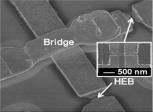


|
In recent years, technologists have intensified their efforts to develop imaging systems operating in the THz region for those promising applications mentioned previously in this letter. To date, the THz imaging systems that have been demonstrated generally fall into one of three categories: (1) single-element imagers that obtain images by mechanical scanning, (2) array imagers (e.g. focal-plane arrays (FPAs)) that consist of an array of imaging sensor elements, and (3) coded-aperture imaging (CAI) using two-dimensional aperture masks.
Building upon our research on high performance THz detectors, THz scanning imaging using the balanced HEB mixers as well as THz FPAs based on the developed HBD detectors have been investigated and demonstrated for much improved THz imaging capabilities. Specifically, in order to develop large-scale THz FPAs, novel processing technologies that permit the direct integration of HBDs with planar antenna arrays has been successfully developed. In addition, a submicron airbridge contact technology for minimizing interconnect parasitics in a pixel element has been introduced for array operation beyond 600 GHz. Concepts developed in this project will pave the way for making compact large scale THz cameras with high spatial resolution and low noise, which are suitable for security screening, explosive detection, through-barrier imaging and aviation applications (e.g., piloting, landing, missile guiding).
Compared to THz imaging using mechanical scanning and FPAs, more advanced technique using CAI offers the advantage of both high performance as well as the potential for realizing simple and low-cost systems. CAI-based systems are based on spatial encoding and modulation to eliminate the need for detector arrays. In collaboration with Prof. H. G. Xing, and with the support form an NSF grant, we have successfully demonstrated graphene THz modulators based on intraband transition, and applied an array of these modulators for THz CAI. Our more recent approach to realize reconfigurable aperture array masks for THz CAI is based on a pioneering work initiated by my group – continuous THz wave spatial modulation using photo-induced free carriers in semiconductors. Using this approach, high performance THz imaging with a frame rate approaching real-time (i.e., 24 fps) has been demonstrated. Imaging systems resulted from this research could be widely deployed in low-cost diagnostics and rapid screening of skin disease and cancers.
THz imaging approaches discussed above are based on quasi-optical techniques and generally result in diffraction-limited imaging resolution, i.e., one-half of the wavelength defined by the Abbe barrier. In order to break this barrier to realize THz imaging with sub-wavelength resolution, my group has spent considerable amount of effort on investigation of advanced methodology and metrology for near-field imaging and spectroscopy beyond 1.6 THz. |
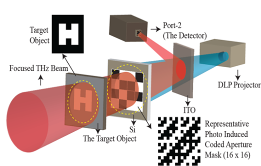
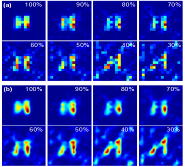
|
THz research has reached a stage that is demanding more advanced circuits and components after substantial progress in sources and detectors. One of the key components mostly desired for advanced applications is a tunable/reconfigurable THz component that enables us to implement various functions and encode information on THz waves. Such functional THz devices are still scarce but in high demand for sophisticated circuits and systems needed in advanced THz sensing, imaging and communications. Two different approaches have been explored (in my group) to realize tunable/reconfigurable THz circuits and components – the approach taking advantages of the THz spatial optical modulation (TSOM, as described in the previous section) and the other using tunable varactor diodes. Using the TSOM mechanism, in addition to the reconfigurable CAI masks, tunable THz modulators achieving a maximum modulation depth of ~35 dB in the WR-1.5 frequency band (500-750 GHz) have been demonstrated. More over, photo-induced tunable Fresnel-zone-plate (FZP) antennas with the capability of dynamic beam steering and forming have been designed and demonstrated at 750 GHz. These tunable/reconfigurable circuits and components have been successfully applied in THz beam mapping, antenna characterization and remote scanning imaging. Research on THz tunable focusing devices and filters, as well as initial demonstration of adaptive THz wireless communication links will be performed soon. In addition to the TSOM approach, frequency tunable antennas in G-band (140-220 GHz) have also been demonstrated for the first time using Schottky varactor diodes. This approach enables the development of a variety of tunable/reconfigurable THz circuits and components such as tunable detectors, reconfigurable mesh filters and beam steering/forming arrays. |

|
5. Nano Technologies for THz Shielding and Passive Components |
|
Advances in THz sources, detectors and instrumentation have fueled unprecedented growth in the development of THz circuits and communication systems, making electromagnetic interference (EMI) shielding in the THz frequency range increasingly more important. Effective THz shielding and attenuation devices are required in many THz circuits and quasi-optical systems, where not much research has been performed to date. Furthermore, THz EMI shielding may have applications in security and defense to protect information detectable by THz imaging and sensing techniques. Finally, a high EMI shielding effectiveness is the basis for making high performance and low-cost THz quasi-optical components, such as polarizers and mesh filters. In collaboration with Prof. C. M. Megaridis in the Department of Mechanical and Industrial Engineering at University of Illinois at Chicago, we have systematically studied the THz EMI shielding properties for nanomaterials including carbon nanofiber (CNF), carbon nanowisker (CNW) and graphene composites. A broadband shielding effectiveness of ~32 dB was measured and the attenuation level could be modified by varying the CNF/CNW loading content. On the basis of this work, we further developed a novel process for making cost-effective THz quasi-optical components using inkjet printed CNW coatings. |
|
6. THz Microfluidics for Chemical and Biological Sensing |
|
In recent years, electromagnetic radiation in the THz region has also emerged as a powerful tool for identifying molecular conformational information. Unlike conventional optical approaches (i.e. visible, ultraviolet and infrared), in which events such as molecular stretching or electron transition induced photon excitation are involved, a THz-based sensing scheme is intrinsically associated with low-energy events such as molecular torsion or vibration as well as inter- and intramolecular hydrogen-bonding. These mechanisms make THz sensing an ideal non-invasive and remote detection and characterization tool for a broad range of substances, including drugs, explosives and biomolecules. However, when dealing with aqueous and polar liquid samples, this ability has been greatly limited due primarily to the strong interaction between THz radiation and the low-frequency intermolecular vibrations involving hydrogen bonds. In most cases, the induced THz absorption in the aqueous media or matrices (e.g. water) dominates the signal output, making it very difficult to identify and characterize target analytes present in solution. To circumvent this problem, we have integrated transmission-mode frequency-domain THz spectroscopy and microfluidic devices for real-time monitoring and mapping of molecular diffusion and chemical reactions under dynamic multiple-stream laminar conditions. This area is still a research direction at its very early infancy, but our promising results have suggested an enormous potential in a wide range of chemical and biological sensing applications. |
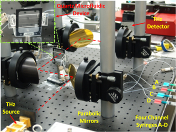

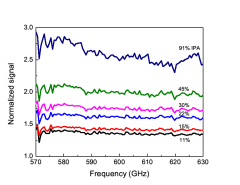

|
4. Optically-Controlled THz Waveguide Architectures |
|
In addition to quasi-optical THz devices, and on the basis of our pioneering work on optically-tunable THz waveguide attenuators/modulators (“Investigation and demonstration of a WR-4.3 optically controlled waveguide attenuator,” IEEE Trans. TST, vol. 7, no. 1, pp. 20-26, 2017), more ambitious ideas to realize more advanced tunable/reconfigurable mmw-THz devices (e.g., switches, phase shifters) using optically-controlled waveguide architectures including photo-induced electromagnetic band gap structures and dynamically reconfigurable substrate-integrated waveguides have been proposed. This approach is unique and promises to generate a paradigm shift in the way that advanced, tunable, and reconfigurable THz circuits are designed.
|
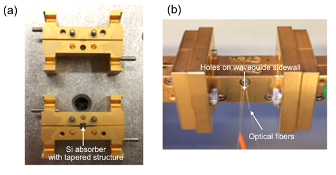


|
THz Circuits and Systems Lab |
